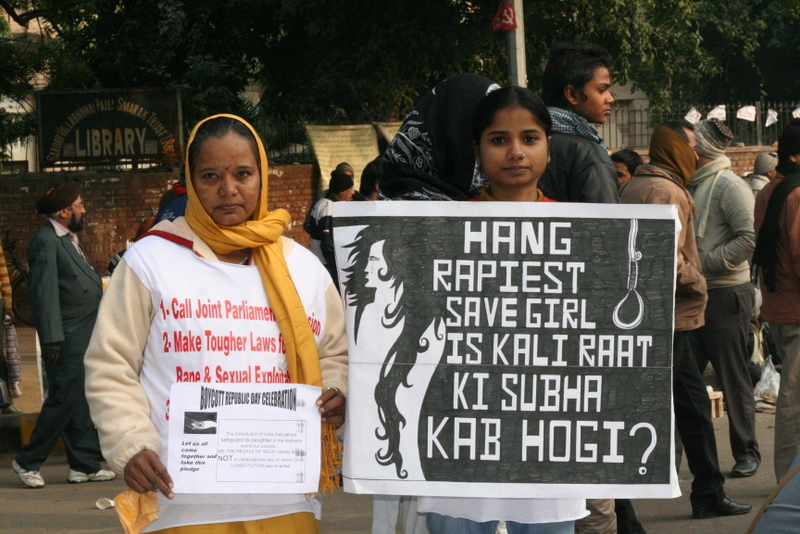On 14th Sepetember 2020, an adolescent woman was brutally gang raped in India. This article examines the gender- and caste-based hiearchies, and how it has affected the case.
Yet another victim to gang rape has succumbed to injuries in the state of Uttar Pradesh in India. A nineteen year old woman died after battling with her injuries for fourteen days.
The infamous 2012 Nirbhaya case set precedent for allowing capital punishment specifically brutal rapes. While the victim’s family welcomed this punishment, many have raised concern on this. A fear of capital punishment, rather than deterring future rapes, will encourage the perpetrators to kill their victims after the rape. Unfortunately, this fear has also rung true at least to some extent.
Since the infamous Nirbhaya gang rape, instances of rapes have become more visible in India. Every year, reported rapes have increased in numbers. It is estimated that every 20 minutes, a woman gets raped in India. Many predict that thousands of rapes go unreported each year due to the stigma attached to it.
Caste-based impunity
Adding to this is the dimension of the traditional caste-based hierarchy of India. The woman belonged to the Dalit caste: previously called the untouchables. Her perpetrators, on the other hand, were all from the upper-caste. This spells a recipe for impunity. Police have previously been accused of negligence and downright covering up of information in order to protect the perpetrators. The police’s actions in this case suggest a similar cover-up.
Local journalists report that the police tried to force the woman’s family to cremate her immediately. When her family did not oblige, the local police forcefully cremated her body in the middle of the night. They forming a human chain to ward off community and family members. In addition to insensitivity to the victim’s family, the immediate cremation is also a coverup for any possible information.
On top of that, despite the dying victims rape allegations, Additional Director General of Police (Law and Order) of the state, Prashant Kumar, made the following statement
“The forensic science laboratory report clearly says that sperm was not found in the samples collected from the woman… The report has made it clear that the woman was not raped,”
Medically, rape is evidenced by the signs of struggle and physical abuse in a woman’s body. Semen, on the other hand, is used to identify the perpetrator(s). It is not a determinant of whether a rape occurred or not. The ignorant statement from a senior officer of an investigating body clearly points to a foul play on an institutional level.
Individual or systemic violence?
An ex-supreme court judge made the following statement in response to the case:
”Sex is a natural urge in men. It is sometimes said that after food, the next requirement is sex. In a conservative society like India, one can ordinarily have sex only through marriage. But when there is massive and rising unemployment, a large number of young men remain deprived of sex, even though they have reached an age when it is a normal requirement. I once again make it clear that I am not justifying rapes, rather I condemn it. But considering the situation prevailing in the country, they are bound to increase. So if we really want to end or reduce rapes we have to create a social and system in India in which there is no or little unemployment”
The statement has been criticized in social media for faulty logic, and for trying to shift the blame from the individual to systemic forces.
The statement is problematic for many reasons. It places almost no responsibility on the perpetrator for his actions. Rather the rapists’ actions are justified through unfulfilled sexual urges. Most importantly, the completely misses out the major systemic forces behind the increasing rapes: patriarchy.
It is patriarchy that creates the entitlement that men claim over women and their bodies. It is patriarchy that deters women from reporting sexual abuses in fear of stigma. It is patriarchy that allows men to threaten women with physical harm for reporting. It is patriarchy that blames the woman for getting raped, while the man gets an excuse of “acting on his sexual urges.” It is patriarchy that allows men the confidence of getting away with a crime like this.
The above statement also ignores the caste-based oppression that has allowed members of the higher caste to commit such acts against members of the oppressed groups. The caste-based oppression also gets the law enforcing agencies to align with the oppressor, instead of the oppressed.
The case is not an anomaly. There have been numerous cases where police refuse to file an official report against the high-caste perpetrators. There are also many instances where women’s allegations of rapes have been questioned despite clear evidences in their bodies. Rapes where law enforcing agencies destroy the evidences are also not rare.
The resulting impunity is created by systems of oppression: gender-based, caste-based, class-based. Dismantling these systems of oppression is imperative to ensure justice to victims.
Featured image: Protest in 2012 against Nirbhaya gang rape case via Flicker

One thought on “Victim of Gang Rape Succumbs to Injury”